Author: Liu Honglin
A year later, I returned to the Hong Kong Convention and Exhibition Centre to attend the Web3 Carnival. People have path dependence; seeing the exhibition area listed on the poster as being on the 5th floor, I confidently took the same stairs as last year and went straight up to the fifth floor, only to find out… I was wrong.
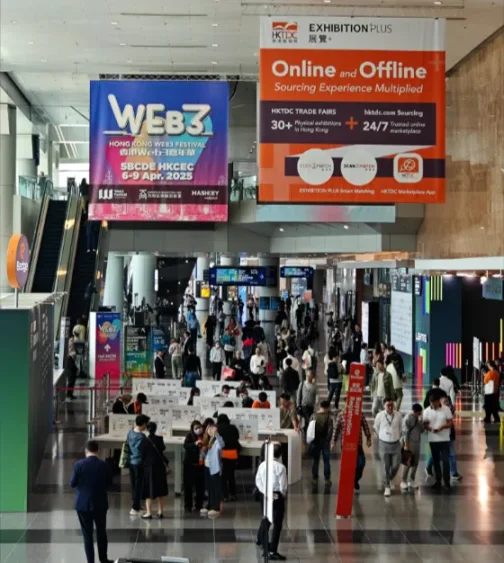
When I returned to the first-floor lobby, I was still relieved that I had made a mistake. As I climbed the stairs, I couldn't help but reflect that even if the industry is struggling, it shouldn't be this bleak.
Upon reaching the proper entrance, I collected my ticket and entered. The first exhibition area I saw was Hashkey and OKX. Exchanges are indeed the backbone of the current Web3 industry, and that is not wrong. Interestingly, OKX has not obtained a license in Hong Kong, yet it is anything but low-key there. If you say that the relevant leaders of the Hong Kong government are unaware of OKX's presence in Causeway Bay, I wouldn't believe it at all.
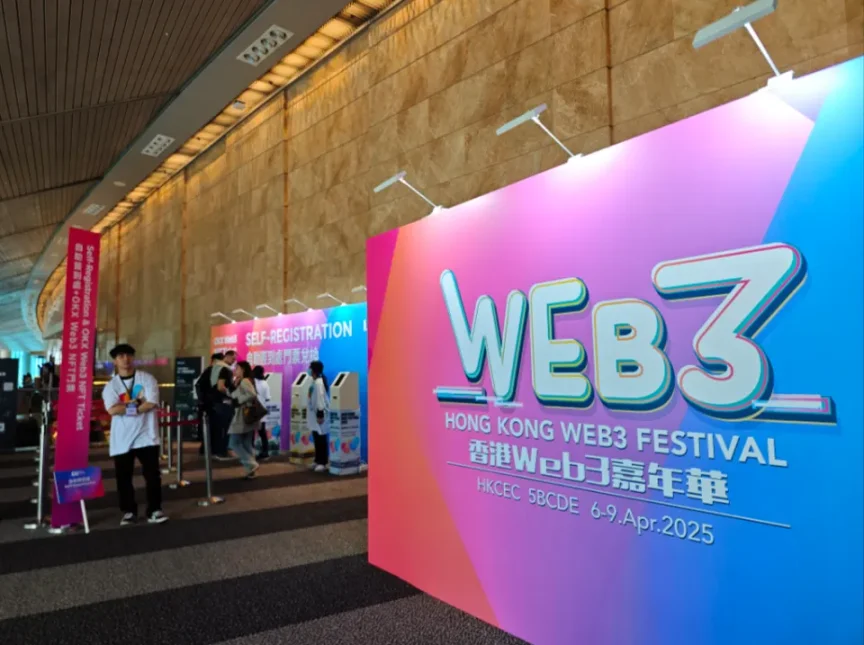
This year's venue theme of spring, summer, autumn, and winter is quite nice. From a market perspective, I think retaining just one winter would suffice. I particularly liked the vertical banners of Chinese poetry at the main stage; indeed, the combination of traditional Chinese aesthetics with global topics feels very cyber and punk.
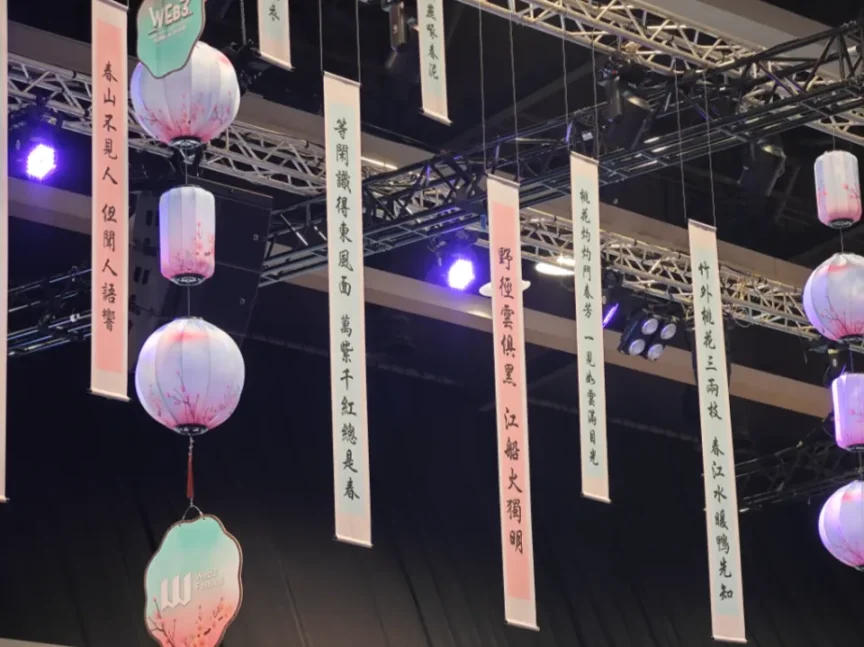
It is said that the entire exhibition area has increased in size by 1.5 times compared to last year. As a result, the overall attendance at the venue seems to be much quieter than last year. This is not just my observation; several partners I met at the venue shared the same impression. Last year, the Mankun team had a booth at the venue, and seeing the state of this year's venue, I was relieved that my team members didn't have to endure four days here. While exploring the exhibition, I also encountered partners from Conflux; they did not exhibit this year but instead found a bar nearby to hold an event, which likely diverted some of the crowd. This is probably a significant reason for the reduced attendance. People will find that such events are merely a place for gatherings; they can happen both inside and outside the venue.
One of the key themes of the event on the 7th was PayFi. I listened to executives from Yuan Coin, ZAbank, HSBC, and others share their insights. In the audience, I also ran into a few old friends from Web2 payment companies. Recently, they have started to pay attention to the combination of Web3 and the payment industry. Outside the venue, I visited various payment concept booths and communicated with their staff about their business scenarios and product services. The core focus remains two: Tob's cross-border payments and Toc's USDT bank cards.
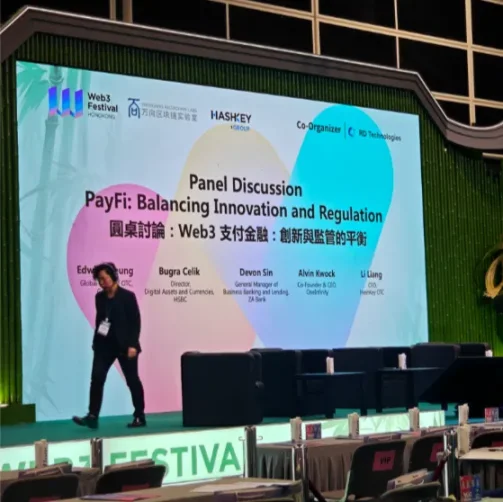
I feel that USDT bank cards have become somewhat mixed. It worries me that there might be agents dealing with USDT bank cards who could abscond with funds. Therefore, everyone should be cautious when using USDT bank cards from lesser-known institutions. Don't just focus on low transaction fees; the other party might be eyeing your deposited principal.
The once-popular Depin track was completely absent from this year's venue. The only project related to hardware that I saw was a robotic dog from an unknown exhibitor in the middle of the venue.
Surprisingly, I saw that the Shanghai Data Exchange also came to exhibit. General Xie and Ray from the exchange were at the booth, and as I approached, everyone greeted each other warmly. Their main focus at the exhibition was to introduce services in the RWA track. Many partners came to inquire at their booth, as RWA represents a business scenario that allows mainland companies to connect with Web3. I imagine many traditional businesses, especially those struggling with financing, are pondering this matter. However, I am quite curious and looking forward to how RWA can carve out a path in the mainland.
Another booth related to the RWA concept was from Bosera Fund. From previous PR promotions and the booth's introduction, the general idea is to tokenize traditional money market funds, allowing qualified investors to directly use cryptocurrencies to purchase them on compliant exchanges like Hashkey. This provides a yield product for friends in the crypto space while in a cash position. Of course, I understand that money market funds are just the initial attempt; more fund products should be tokenized and sold on compliant exchanges in the future. From this perspective, cryptocurrency exchanges may, to some extent, also become brokerages. Besides being able to purchase crypto assets on-site, they could also offer securities products. New and old brokerages like Futu Securities and Victory Securities suddenly have another competitive peer in a different track, which is quite interesting.
In addition to the PayFi track, meme coins also had a presence at the venue. I saw at least three or four such exhibiting projects, but I didn't engage much as I found it uninteresting. I met a friend from Shanghai at the venue, and he told me that in recent months, meme coins had cost them several million dollars. Quite lamentable.
Interestingly, I noticed that DWF Labs had a small booth this year. I remember last year they had a large booth with many staff members, so it seems that trading hasn't been very profitable this year. It appears that market makers are having a tough time lately, so they are keeping a low profile.

For public chain projects, the BSC partners left promptly at 4:00 PM. It seems that besides CEX being the mainstream business, other projects overall feel like they are just there to make an appearance. In recent days, two co-founders from Binance have appeared in Hong Kong after many years, and some friends speculate that the Hong Kong government may have further favorable policies. Who knows?

Perhaps I didn't notice, but this year, the relatively popular Sol and Sui public chains in the Chinese-speaking region seemed to be absent from the venue. It makes sense; it seems that no one was discussing technology at the venue; everyone appeared to be focused on finance.
Next to the BSC booth was a project booth called FoX. From my observation, the attendees at this booth were generally older. Based on the information conveyed on-site, I suspect this is somewhat of a CX project.
The Ton ecosystem, apart from the organizers Wanxiang and Hashkey, was the only exhibitor that felt like a real ecosystem. In a certain exhibition area, Ton and about a dozen projects within its ecosystem gathered to form a street, which seemed organized and disciplined. I noticed that the main focus was on on-chain trading, e-commerce, and casual games, but the crowd in front of the booth wasn't very lively. Thinking back to last year, Ton had even hosted a sub-forum, and in comparison, it now feels quite desolate. Many from Ton's team in the Chinese-speaking region must have left; a good friend of mine left Ton to start his own project shortly after the Web3 Carnival last year.

At the venue, I was occasionally recognized and greeted by some unfamiliar partners, who warmly said, "Aren't you Liu Honglin from Mankun?" It shows that my daily work of writing and shooting short videos has indeed yielded positive feedback. I need to keep up the effort and produce more useful content for everyone.
I stayed at the venue listening to talks and chatting with friends until the exhibition ended. After exiting, I had to prepare to re-enter for something, but at the entrance, I was stopped by an elderly man speaking Cantonese, who said that the entry time had passed and I could not go in. I explained that I had just come out and needed to find someone quickly, but he insisted it was not allowed since the entry time had passed. In mainland China, this would be an art of communication, but thinking about it, this is Hong Kong, and people's understanding of rules seems a bit different, so I gave up.

I flew directly from Shanghai to Hong Kong in the morning, taking the airport express to Hong Kong Station. I checked the walking distance to the convention center: 30 minutes. So, I walked along the seaside, enjoying the sunny weather and the vibrant spring atmosphere. There were people jogging by the sea and others lying on the lawn having lunch and sunbathing, showing me another side of Hong Kong beyond the hustle and bustle. Entrepreneurship and hard work are all for a better life.
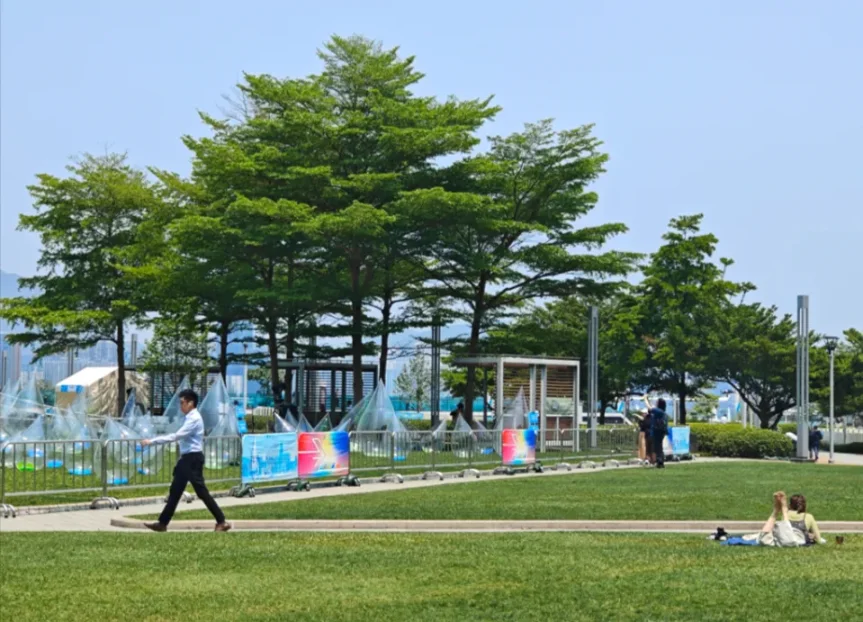
The entry of sovereign nations and traditional financial institutions is the core narrative of this bull market. Recently, the unreliable actions of the U.S. president have made the world seem increasingly absurd, filled with uncertainty. The global financial market has seen a significant decline, especially in the crypto market. Last night, I saw a message in my social circle stating that since Trump took office, the global cryptocurrency market cap has dropped by $1.1 trillion. It is difficult to predict market fluctuations, but my personal view is that Web3 entrepreneurship has never been about the logic of financial markets; products and services that truly meet user needs are the real tools to combat cycles.
During the exhibition, the Hong Kong government announced that it would release another policy declaration regarding Web3 later this year, further implementing related encouragement and development systems. Friends often say that the Hong Kong government has been slow in its Web3 layout. However, my view is that for a city with a history of over a hundred years, this speed is quite acceptable. We often overestimate the changes in one year but underestimate the power of ten years.
The road is long and obstructed, but I remain full of confidence in the future of Web3.0 in China.

免责声明:本文章仅代表作者个人观点,不代表本平台的立场和观点。本文章仅供信息分享,不构成对任何人的任何投资建议。用户与作者之间的任何争议,与本平台无关。如网页中刊载的文章或图片涉及侵权,请提供相关的权利证明和身份证明发送邮件到support@aicoin.com,本平台相关工作人员将会进行核查。




